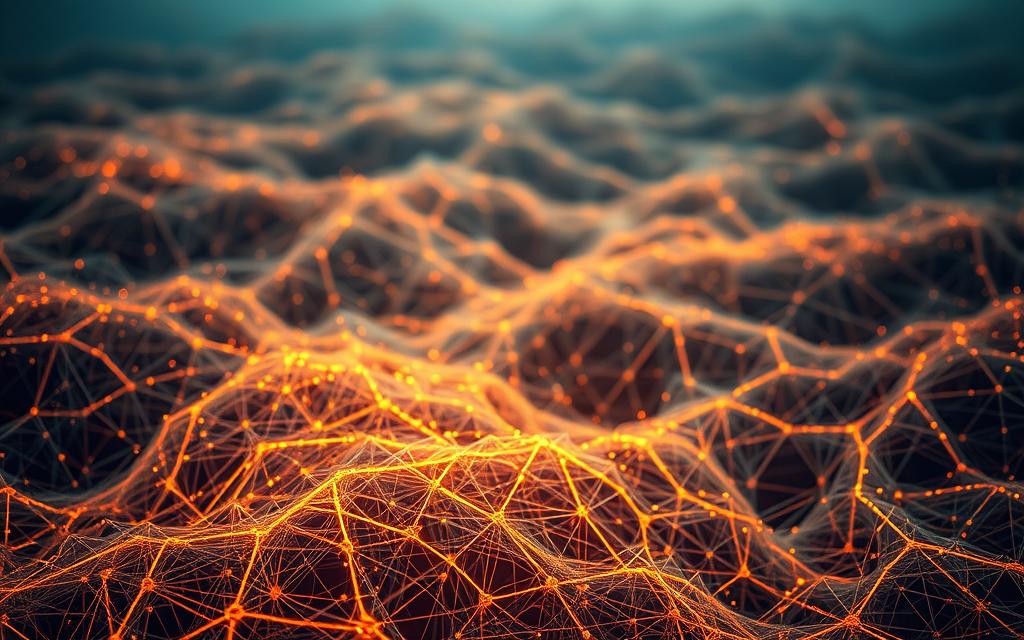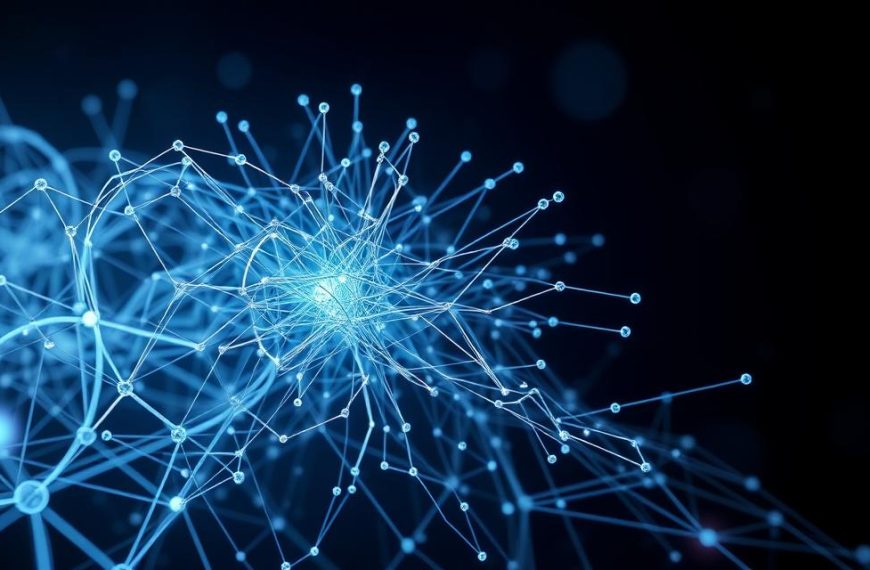Just a decade ago, deep learning was seen as a minor part of AI research. Many thought neural networks were too complex for everyday use.
But around 2012, everything changed. Three key things came together. Breakthroughs in algorithms like backpropagation laid the groundwork.
Then, huge datasets like ImageNet provided the training data needed. And GPU acceleration, thanks to CUDA, gave the power to process it all.
This mix of innovation made deep learning a key player in the AI revolution. It’s now at the heart of artificial intelligence, changing fields like computer vision and natural language processing.
The story shows that progress often comes from combining data, hardware, and new ideas. It’s not just one thing that makes a difference.
The Fundamental Architecture of Deep Neural Networks
Deep neural networks are powerful because of their complex design. They have layers that work together like our brains do. Each layer changes the data in a special way, helping the network learn more.
Multi-Layered Structure and Hierarchical Learning
Deep neural networks are organised in layers. Each layer uses what the previous one found. This way, the network gets better at understanding data.
How depth enables progressive feature abstraction
Early layers spot simple things like edges. Later layers mix these into more complex shapes. The last layers put it all together into objects or ideas.
This process is like how our eyes see the world. Deep networks can do this complex learning that shallower ones can’t.
Critical Role of Activation Functions
Activation functions add non-linearity to neural networks. Without them, networks would just be simple. The right function can make learning faster and better.
Sigmoid, tanh, and ReLU: Comparing non-linear transformations
Each activation function has its own strengths. Sigmoid is good for predicting probabilities. Tanh works well for many tasks.
ReLU, introduced in 1969, is now the most used. It keeps values above zero and changes negative ones to zero. This helps training go faster.
| Activation Function | Range | Advantages | Limitations |
|---|---|---|---|
| Sigmoid | (0, 1) | Smooth gradients, probabilistic interpretation | Vanishing gradients, computationally expensive |
| Tanh | (-1, 1) | Zero-centered output, stronger gradients | Vanishing gradients at extremes |
| ReLU | [0, ∞) | Computationally efficient, reduces vanishing gradient | Dying ReLU problem for negative inputs |
“The introduction of ReLU activation functions marked a turning point in deep learning, enabling training of previously intractable deep architectures.”
Weight Initialisation Strategies
Starting with the right weights is key for deep neural networks. If the weights are too big or too small, training can fail. Good initialisation methods avoid these problems.
Xavier and He initialisation methods for stable training
Xavier initialisation scales weights based on the number of neurons. It keeps the variance of activations and gradients consistent. It’s great for sigmoid and tanh.
He initialisation is for ReLU. It adjusts for ReLU’s zeroing of negative values. It’s the go-to for ReLU and its variants.
Both Xavier and He are big steps forward in starting weights. They help gradients flow well through deep networks. This is vital for training networks with many layers.
Mathematical Foundations Enabling Deep Learning
Deep learning systems owe their success to a complex mathematical framework. Three key areas of math work together. They help neural networks learn from data and make accurate predictions.
Linear Algebra Operations in Neural Networks
Deep learning uses linear algebra at its core. Neural networks process information through matrix operations. These operations transform input data through layers.
Matrix structures help handle large numbers of parameters efficiently. They allow for parallel computations that modern hardware can speed up a lot.
Matrix multiplication efficiency in forward propagation
Matrix multiplication is key in the forward pass of neural networks. Each layer multiplies input vectors by weight matrices and adds bias vectors.
This method lets networks process data in batches, not one example at a time. GPUs are great at these operations, doing thousands of calculations in parallel. This makes training deep networks possible.
Matrix operations are mathematically elegant and boost computational performance. This is vital as networks and datasets grow.
Calculus Principles in Gradient Computation
Calculus is essential for neural network learning. During training, networks adjust parameters based on error contributions.
Calculating gradients is key. These gradients show how to adjust parameters for better performance. They guide the network to optimal settings.
Partial derivatives and the chain rule in backpropagation
The backpropagation algorithm uses calculus to compute gradients. It breaks down the problem into manageable steps. Each layer calculates local gradients that flow backward, enabling efficient learning.
Rumelhart, Hinton, and Williams introduced this method in 1986. Their work showed how calculus can train multi-layer networks.
Probability and Information Theory Applications
Deep learning is closely tied to probability theory. It deals with uncertainty and prediction. Networks often give probabilistic outputs, reflecting real-world uncertainty.
This framework allows models to express confidence in predictions. It supports nuanced decision-making based on likelihood estimates.
Cross-entropy loss and probabilistic interpretations
The cross-entropy loss function links neural networks to information theory. It measures the difference between predicted and true probability distributions.
Minimising cross-entropy reduces the extra information needed for true labels. This aligns with the goal of accurate predictions.
Many loss functions build on this probabilistic foundation. These mathematical formulations justify and guide training effective models.
Why Does Deep Learning Work: Core Theoretical Explanations
Deep learning’s success comes from more than just its maths and design. Several key ideas explain how it works so well. These ideas show how neural networks can spot complex patterns in data.
The Universal Approximation Theorem
The universal approximation theorem is a big deal in neural network theory. It shows that a simple network can get very close to any function, with enough neurons.
Mathematical proof of neural networks’ representational power
This theorem proves that neural networks can handle a huge range of functions. They can go from simple to very complex, thanks to their design.
This power is the foundation of deep learning’s success. It means that any problems are usually about data, not the network itself.
Distributed Representation Advantages
Deep learning gets better because it uses distributed representations. This means ideas are spread out among many neurons, not just one. It’s different from older AI systems.
Exponential efficiency gains through feature sharing
Using distributed representations makes deep learning much more efficient. It lets the network handle many ideas with just a little more power.
This way of representing ideas helps the network generalise better. It learns patterns, not just specific examples. This makes it better at dealing with different inputs.
Compositional Structure Benefits
Deep networks are structured like the natural world. This similarity helps them learn and understand in a way that’s similar to us.
How hierarchical composition mirrors natural intelligence
Deep networks build up complex ideas from simple ones. This is like how our eyes see the world, from edges to objects.
This structure lets networks understand complex data in a natural way. It’s very good at handling real-world information.
The key ideas of universal approximation, distributed representations, and compositional structure explain deep learning’s success. They show why it works so well in many areas.
Training Algorithms That Power Deep Learning
Deep learning models are amazing thanks to complex training processes. These processes turn simple neural networks into smart systems. The training algorithms are key to this transformation, helping networks learn and get better over time.
Backpropagation: The Learning Engine
Backpropagation is the main algorithm for deep neural networks to learn from mistakes. It figures out how each connection weight affects the error. This lets the network make precise changes.
Error signal propagation through network layers
The algorithm sends error signals back through the network layers. It starts at the output layer, calculating each neuron’s error contribution. Then, it moves back through the hidden layers.
This backward journey helps the network assign blame for errors to specific connections. Each weight gets updated based on its error contribution. This process is essential for deep learning, allowing efficient gradient calculations across millions of parameters.
Optimisation Techniques and Their Evolution
Backpropagation tells the network what changes to make, but optimisation techniques decide how to make those changes. These methods have grown from simple to complex, speeding up learning.
From basic gradient descent to Adam optimiser
It all started with basic gradient descent, updating weights to reduce error. Though simple, it’s slow for complex models.
Now, we have optimisers like Adam, which are much better. They use momentum and adapt learning rates for each parameter. This makes learning faster and more efficient.
These advancements have greatly reduced training times and improved model performance. The adaptive nature of these algorithms is perfect for deep neural networks.
Regularisation Methods Preventing Overfitting
Deep learning models have millions of parameters, risking overfitting. Regularisation techniques help by favouring simpler, more generalisable solutions.
Dropout, weight decay, and early stopping techniques
Dropout randomly disables neurons during training. This prevents over-reliance on certain connections. It creates an ensemble of smaller networks.
Weight decay adds a penalty for large weights. It encourages the network to use all features, not just a few.
Early stopping stops training when performance on unseen data starts to drop. This prevents memorisation and improves generalisation.
These regularisation methods ensure deep learning models find meaningful patterns, not just noise. They are vital for successful deep learning applications.
Data Characteristics That Drive Success
Architectural innovations and mathematical foundations are key for deep learning. But, the data itself is just as important for great results. Certain data properties help deep networks learn well and outperform traditional methods in many areas.
The Big Data Imperative in Deep Learning
Deep learning models need lots of data to work well. As the amount of data grows, so does the model’s performance. This shows how important big data is for artificial intelligence today.
How data volume compensates for model complexity
Deep neural networks have many parameters. They need large datasets to avoid overfitting. More data helps models find general patterns, not just memorise specific ones.
Fei-Fei Li’s ImageNet dataset showed deep learning’s power. At first, people doubted it. But, AlexNet’s success in 2012 proved its value. The dataset’s size helped the model learn complex visual patterns.
Deep learning needs big data because it’s based on statistics. With enough data, even complex models can generalise well. This makes big datasets essential for top performance.
Automatic Feature Learning Advantages
Deep learning changed machine learning by making feature engineering unnecessary. Deep networks learn the best representations from raw data, not from human-made features.
Reducing manual feature engineering through learned representations
Old computer vision methods used hand-crafted features. These required a lot of domain knowledge and often missed important data aspects. Deep learning automates this, finding features that are perfect for the task.
This automatic feature learning makes machine learning more accessible. The learned representations are often more detailed and effective than human-made ones. This leads to better performance on complex tasks.
Deep networks can build abstract representations through layers. They discover features that humans might find hard to imagine or create manually.
Data Augmentation Strategies
Data augmentation is a great way to increase dataset size and diversity when real-world data is hard or expensive to get. It artificially expands training data through smart transformations.
Expanding training datasets through intelligent transformations
Common techniques include rotation, cropping, and flipping, as well as colour adjustments. These make the data more varied and realistic.
Good data augmentation adds valuable variability while keeping the data meaningful. This makes models more robust and improves generalisation. It does this without needing more data.
Now, there are advanced augmentation strategies like generative methods and domain-specific transformations. These enhance dataset quality and diversity through computation, not manual data collection.
Conclusion
Deep learning has grown from a simple idea to a key part of modern artificial intelligence. It works because of its use of multi-layered neural networks and strong maths. Also, it needs lots of data to learn and improve.
This article has given a detailed look at deep learning’s science. We’ve seen how its architecture, maths, and data work together. Together, they help solve big problems in many fields.
The future of AI is closely linked to deep learning’s progress. Scientists are working hard to make AI models better. They want these models to understand things better and work well even with less data. This will help AI make a bigger difference in healthcare and transport, and more.
Deep learning is a key part of AI’s growth. Its development will make it even more important in our lives and work. It will keep playing a big role in technology for many years.

















